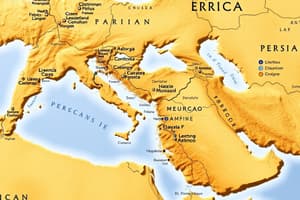Podcast
Questions and Answers
What is an empire, and what were empires' common characteristics during the Classical Era?
What is an empire, and what were empires' common characteristics during the Classical Era?
An empire is a large collection of peoples across a broad geographic range that lives under a common rule. Common characteristics include long trade routes, levied taxes on subjected peoples, enforced religion, organized governments, and armies to maintain order.
How did the number and size of Classical empires compare to the Ancient Era?
How did the number and size of Classical empires compare to the Ancient Era?
Classical civilizations were much larger in land space and population compared to the river civilizations; they were expansionist and deliberately conquered lands.
What were the most influential empires during the Classical Era?
What were the most influential empires during the Classical Era?
Influential empires include the Persian Empires in Southwest Asia, Qin and Han dynasties in East Asia, Maurya and Gupta Empires in South Asia, Hellenistic and Roman Empires in the Mediterranean, Teotihuacan and Maya city states in Mesoamerica, and the Moche in Andean South America.
What techniques did Classical empires use to establish their military power?
What techniques did Classical empires use to establish their military power?
What new political methods were created to rule larger empires in the Classical Era?
What new political methods were created to rule larger empires in the Classical Era?
Flashcards are hidden until you start studying
Study Notes
Understanding Empires in the Classical Era
- An empire is characterized by extensive territories and diverse peoples under a unified governance.
- Common traits of Classical empires include:
- Long trade routes for commerce
- Taxation of conquered populations
- Enforcement of common religious practices
- Military defenses against external threats and organized governance
Expansion of Classical Empires
- Classical civilizations expanded aggressively, unlike earlier river civilizations, resulting in larger empires both in land and population.
Major Classical Empires
- Influential empires included:
- Southwest Asia: Achaemenid, Parthian, and Sassanid Persian Empires
- East Asia: Qin and Han Dynasties in China
- South Asia: Maurya and Gupta Empires
- Mediterranean: Phoenician and Greek colonization, followed by the Hellenistic and Roman Empires
- Mesoamerica: Teotihuacan and Maya city-states
- Andean South America: Moche civilization
Military Power and Techniques
- Classical empires utilized various strategies to enhance military strength:
- Diplomacy was vital, such as the Han Dynasty securing alliances through marriage to neighboring rulers.
- Establishment of tributary states allowed defeated kings to maintain authority in exchange for tribute.
- Supply lines were critical, involving logistics to sustain armies during campaigns.
- Defensive walls were constructed, exemplified by the Great Wall of China and Hadrian's Wall in Britain.
- Road construction, particularly by Romans, facilitated troop movement and defense efforts.
- Empires had to effectively raise armies, with the Roman military regarded as highly effective.
Political Administration Methods
- New governance methods evolved to manage larger empires, including:
- Centralized government structures where decisions were made by a single authority, as seen in Han China and Mauryan India.
- Decentralization in other regions like Gupta India and Zhou Dynasty China, allowing local governance.
- Bureaucracies became essential for maintaining order, with officials trained in Confucian principles in China.
- The legal systems incorporated various cultures, with Rome's Twelve Tables addressing class tensions and evolving as the empire expanded.
Studying That Suits You
Use AI to generate personalized quizzes and flashcards to suit your learning preferences.




